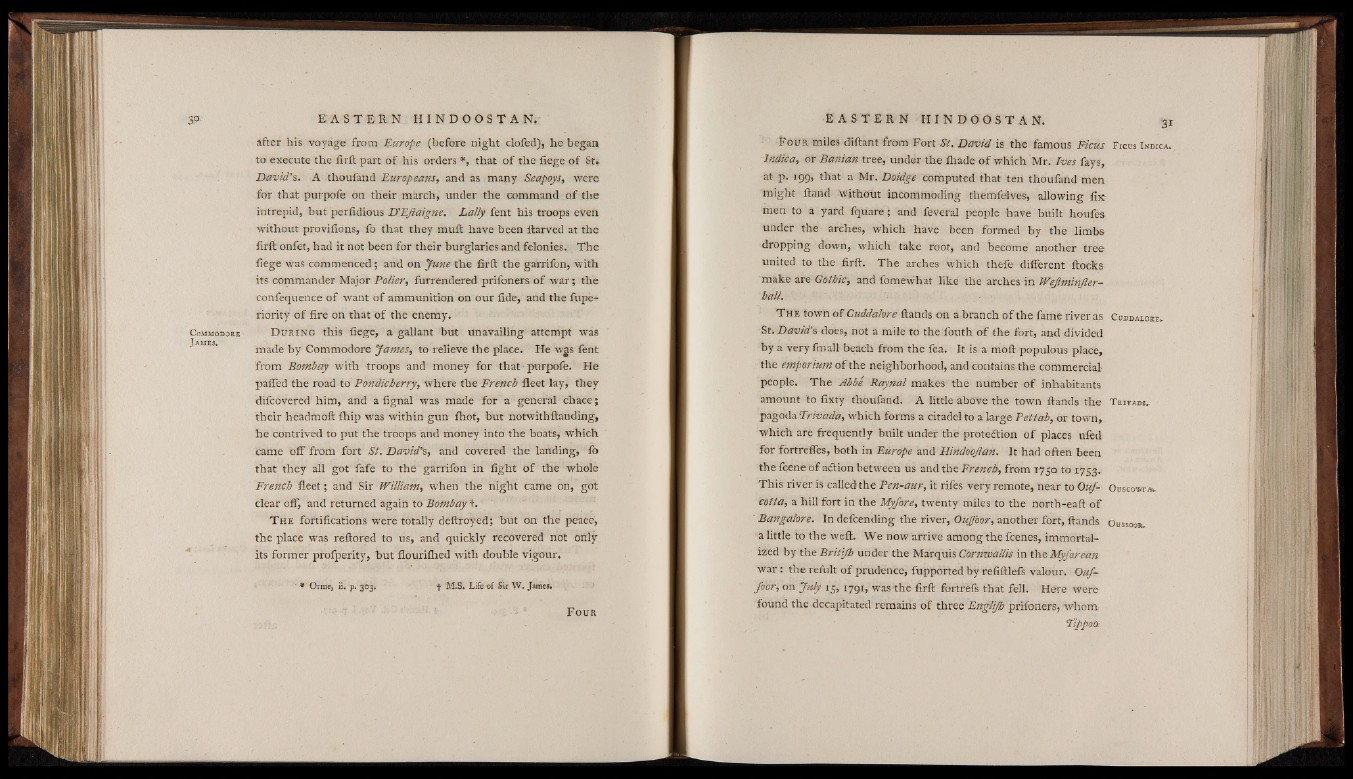
C ommodore
J ames.
after his voyage from Europe (before night clofed), he began
to execute the firft part of his orders *, that of the liege of St.
David’s. A thoufand Europeans, and as many Seapoys, were
for that purpofe on their march, under the command of the
intrepid, but perfidious D'EJlaigne. Dally fent his troops even
without provifions, fo that they muft have been ftarved at the
firft onfet, had it not been for their burglaries and felonies. The
liege was commenced; and on June the firft the garrifon, with
its commander Major Polier, furrendered prifoners o f war; the
confequence o f want of ammunition on our fide, and the fupe-
riority o f fire on that of the enemy.
D u r i n g this liege, a gallant but unavailing attempt was
made by Commodore James, to relieve the place. He was fent
from Bombay with troops and money for that purpofe. He
palTed the road to Pondicherry, where the French fleet lay, they
difcovered him, and a lignal was made for a general chace;
their headmoft Ihip was within gun ihot, but notwithftanding,
he contrived to put the troops and money into the boats, which
came off from fort St. David's, and covered the landing, fo
that they all got fafe to the garrifon in light of the whole
French fleet; and Sir William, w'hen the night came on, got
clear off, and returned again to Bombay +.
T he fortifications were totally deftroyed; bu t on the peace,
the place was reftored to us, and qu ick ly recovered not only
its former profperity, bu t flourilhed w ith double vigou r.
* Orrae, zi. p. 303, i M.S. Life of Sir W . James.
F our
Four miles diftant from Fort St. David is the famous Ficus Fict» In dica.
lndica, or Banian tree, under the lhade o f which Mr. Ives fays,
at p. 199, that a Mr. Doidgè computed that ten thoufand men
might Hand without incommoding themfelves, allowing fix-
men to a yard fquare ; and feveral people have built houfes
under the arches,. which have been formed by the limbs
dropping down, which take root, and become another tree
united to the firft. The arches which thefe different flocks
make are Gothic, and fomewhat like the arches in Wejlminjler-
hall. .
T he town of Cuddalore Hands on ahranch of the fame riveras Cuddalom.
St. David's does, not a mile to the fouth of the fort, and divided
by a very frnall beach from the feâ. It is a moft populous place,
the emporium of the neighborhood, and contains the commercial
people. The Abbé Raynal makes the number of inhabitants
amount to fixty thoufand. A little above the town Hands the T iu y a b i .
pagoda Trivada, which forms a citadel to a large Pettah, or town,
which are frequently built under the protedtion o f places ufed
for fortrefles, both in Europe and HindooJIan. It had often been
the fçene o f adtion between us and the French, from 175a to 1753.
This river is called the Pen-aur, it rifes very remote, near to OuJ- ooscohta..
cotta, a hill fort in the Myfore, twenty miles to the north-eaft of
Bangalore. In defcending the river, OuJJoor, another fort, ftands Oussoo*.
a little to the weft. We now arrive among the fcenes, immortalized
by the Britijh under the Marquis Cornwallis va the Myfarean
war : the refult of prudence, fupported by refiftlefs valour. Ouf-
fo'or, on July 13, 1791, was-the firft fortrëfs that fell. Here were
found the decapitated remains of three Englijh prifoners, whom.
5VippoOs